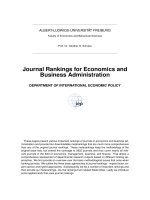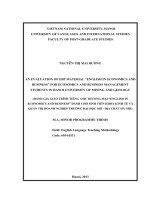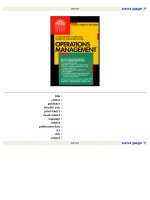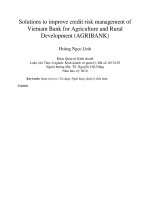Operations management astreamline 3d course for student and business people
Bạn đang xem bản rút gọn của tài liệu. Xem và tải ngay bản đầy đủ của tài liệu tại đây (4.21 MB, 607 trang )
title
author
publisher
isbn10 | asin
print isbn13
ebook isbn13
language
subject
publication date
lcc
ddc
subject
cover
next page >
cover
next page >
:
:
:
:
:
:
:
:
:
:
:
< previous page
page_i
next page >
Page i
Operations Management
Jae K. Shim, Ph.D.
College of Business Administration
California State University, Long Beach
Joel G. Siegel, Ph.D.
Queens College of the City University of New York
< previous page
page_i
next page >
< previous page
page_ii
next page >
Page ii
Copyright © 1999 by Barron's Educational Series, Inc.
All rights reserved.
No part of this book may be reproduced in any form, by photostat, microfilm, xerography or any other means, or
incorporated into any information retrieval system, electronic or mechanical, without the written permission of the
copyright owner.
All inquiries should be addressed to:
Barron's Educational Series, Inc.
250 Wireless Boulevard
Hauppauge, New York 11788
Library of Congress Catalog Card No. 98-27825
International Standard Book No. 0-7641-0510-8
Library of Congress Cataloging-in-Publication Data
Shim, Jae K.
Operations management / Jae K. Shim, Joel G. Siegel.
p. cm. (Business review series)
Includes index.
ISBN 0-7641-0510-8
1. Production management. I. Siegel, Joel G. II. Title.
III. Series.
TS155.S4535 1999
658.5dc21
98-27825
CIP
PRINTED IN THE UNITED STATES OF AMERICA
98765432
< previous page
page_ii
next page >
< previous page
page_iii
next page >
Page iii
Contents
Preface
viii
1
The Scope of Operations and Production Management
General Description of Production and Operations Systems
Manufacturing Operations versus Service Operations
Operations Strategy
Productivity
Total Quality Management and Quality Costs
Continuous Improvement
KNOW THE CONCEPTS
Do You Know the Basics?
Terms for Study
Practical Application
ANSWERS
2
Decision Making: Concepts and Tools
Decision Making under Uncertainty
Decision Matrix
1
3
5
6
8
9
17
20
20
21
21
22
26
27
28
Decision Trees
Modeling a Real-Life System
Linear Programming
KNOW THE CONCEPTS
Do You Know the Basics?
Terms for Study
Practical Application
ANSWERS
3
Forecasting
Who Uses Forecasts?
Forecasting Methods
Selection of Forecasting Method
The Qualitative Approach
Steps in the Forecasting Process
Moving Averages and Smoothing Methods
Regression Analysis
Regression Statistics
Use of Computer Software for Regression
Multiple Regression
31
35
38
50
50
51
51
56
65
66
67
67
68
69
70
78
81
84
85
85
Time Series Analysis and Classical Decomposition
94
Computer Software for Forecasting
95
Evaluation of Forecasts
< previous page
page_iii
next page >
< previous page
page_iv
next page >
Page iv
KNOW THE CONCEPTS
Do You Know the Basics?
Terms for Study
Practical Application
ANSWERS
4
Product Planning, Process Selection, and Capacity Planning
Product Design
Interaction between Product Design and Production Costs
Basic Product Design Alternatives
Quality Function Deployment
Processes and Process Planning
General- and Special-Purpose Equipment
Automation
Process Planning
Product Analysis
MakeBuy Analysis
Process Selection
Reliability and Maintenance
98
98
99
99
103
114
116
117
118
119
119
121
122
124
125
129
130
131
Capacity Planning
Evaluating Alternative Capacities
KNOW THE CONCEPTS
Do You Know the Basics?
Terms for Study
Practical Application
ANSWERS
5
Facility Location
Factors in Location
Site Selection
Multiplant Location
Special Considerations in Location Decisions
Location Decisions
KNOW THE CONCEPTS
Do You Know the Basics?
Terms for Study
Practical Application
ANSWERS
6
Design of the Work System and Work Measurement
139
142
145
145
145
146
149
155
156
156
157
157
158
169
169
169
170
172
179
180
Work and Job Design
185
Work Measurement and Production Standards
187
Work Measurement Systems
194
Learning Curve
< previous page
page_iv
next page >
< previous page
page_v
next page >
Page v
KNOW THE CONCEPTS
Do You Know the Basics?
Terms for Study
Practical Application
ANSWERS
7
Facilities Design and Layout
Layout of Facilities
Material-Handling Methods
Classical Layout Types
Minimization of Material-Handling Cost
Systematic Layout Planning
Computerized Plant Layouts
Product Layout and Line Balancing
Balancing Techniques
A Plant Layout Decision
KNOW THE CONCEPTS
Do You Know the Basics?
Terms for Study
197
197
198
198
200
205
206
207
207
211
211
213
214
218
221
223
223
224
Practical Application
ANSWERS
8
Aggregate Planning and Master Scheduling
The Production Planning Process
Aggregate Planning
Master Scheduling
Computerized Scheduling Systems
Operations Scheduling
KNOW THE CONCEPTS
Do You Know the Basics?
Terms for Study
Practical Application
ANSWERS
9
Inventory Management
Economic Order Quantity and Reorder Point
EOQ with Noninstantaneous Replenishment
EOQ with Quantity Discounts
Determination of Safety Stock
The Single Period Inventory ProblemMarginal Analysis
224
226
231
232
233
246
247
247
256
256
256
256
260
268
269
272
274
279
283
285
Computers and Inventory Planning
286
Simulation
289
Using the ABC System for Inventory Control
< previous page
page_v
next page >
< previous page
page_vi
next page >
Page vi
KNOW THE CONCEPTS
Do You Know the Basics?
Terms for Study
Practical Application
ANSWERS
10
Material Requirements Planning and Just-in-Time
Material Requirements Planning
Manufacturing Resource Planning
Just-in-Time Manufacturing
MRP versus JIT Systems
Value Analysis (or Value Engineering)
KNOW THE CONCEPTS
Do You Know the Basics?
Terms for Study
Practical Application
ANSWERS
11
Facilities Investment Decisions
What Are the Features of Investment Projects?
292
292
293
293
297
305
306
316
316
329
330
331
331
331
332
335
342
343
Understanding the Concept of Time Value of Money
How Do You Evaluate Facilities Investment Projects?
How Do Income Taxes Affect Investment Decisions?
KNOW THE CONCEPTS
Do You Know the Basics?
Terms for Study
Practical Application
ANSWERS
12
Project Management
Project Scheduling Models
Gantt Charts
Program Evaluation and Review Technique
The Critical Path Method Model: PERT/Cost
Computer Software for Project Management
KNOW THE CONCEPTS
Do You Know the Basics?
Terms for Study
Practical Application
ANSWERS
343
346
350
352
352
353
353
355
361
362
362
363
373
378
378
378
379
379
383
< previous page
page_vi
next page >
< previous page
page_vii
next page >
Page vii
13
Waiting Lines and Queuing
Queuing or Waiting Lines
Using Queuing Analysis to Analyze Operations
Structure of Queuing (Waiting Line) Problems
Analytical Models for Waiting Lines
Queuing Notations
Computer Simulation for Waiting Lines
KNOW THE CONCEPTS
Do You Know the Basics?
Terms for Study
Practical Application
ANSWERS
14
Quality Assurance
Pareto Analysis
Statistical Quality Control
Acceptance Sampling for Attributes
Types of Sampling Plans
Control Charts for Attributes
390
391
392
394
395
397
411
411
411
412
412
415
422
423
424
430
438
440
443
Computer Software for Quality Control
443
KNOW THE CONCEPTS
443
Do You Know the Basics?
444
Terms for Study
444
Practical Application
447
ANSWERS
Glossary
454
Appendix I. American Production and Inventory Control Society
462
Appendix II. Tables
465
Index
477
< previous page
page_vii
next page >
< previous page
page_viii
next page >
Page viii
Preface
This book provides a clear and concise introduction to operations management, which involves the planning,
coordinating, and executing of all activities that create goods or services. The course operations management is
offered in a variety of titles including production and operations management, analysis for production systems, and
design and engineering of production systems, at both the undergraduate and graduate levels.
This book is an excellent supplement to those courses. It focuses on the fundamentals and essentials needed to
understand how operations strategies are carried out and how they are tackled using new concepts and tools. It
illustrates decisions with many solved problems to test and help students reinforce their understanding of the subject.
It covers many application-oriented problems that help readers to relate, to integrate, to discover, and, in general, to
gain useful insights. Further, many business professionals can benefit from this up-to-date book containing the latest
techniques and methods.
The book presents, in an integrated fashion, much of the material covered in the exams leading to professional status
as a Certified Production and Inventory Manager (CPIM) or Certification in Integrated Resource Management
(CIRM). The CPIM exams and certification are administered by the American Production and Inventory Control
Society (APICS). In 1991, APICS also initiated the CIRM program with the intention of establishing the
internationally recognized standard for excellence in the field of integrated resource management.
Throughout the text, you are advised to follow the following ground rules to enhance benefits:
1. Understand the Definitions and Key Points. Each chapter begins with Key Terms, which are discussed throughout
the chapter. It is followed, wherever applicable, by You Should Remember boxes, which summarize key points.
2. Study Each Example Over and Over Again. Be sure to work out each example. This is the key process of learning
and understanding the chapter material. Of course, you will be tested with similar problems at the end of the chapter.
You will be provided with suggested solutions so that you can check your answers.
3. Do All Problems. Do You Know the Basics tests your understanding of the main concepts of the chapter. Practical
Applications test your ability to handle analyticalmostly numericalproblems. Do not fail to do both!
< previous page
page_viii
next page >
< previous page
page_ix
next page >
Page ix
If you stick to this game plan and work at it, you will be assured of enhancing your understanding of operations
management and be successful in the course. By the same token, business professionals will gain a better
understanding of the subject and be able to apply the tools to make informed decisions.
The authors are grateful to Allison Shim for her enormous word processing and editorial assistance.
JAE K. SHIM
JOEL G. SIEGEL
< previous page
page_ix
next page >
< previous page
page_1
next page >
Page 1
1
The Scope of Operations and Production Management
KEY TERMS
business process reengineering (BPR)
management practice seeking to make revolutionary changes in business processes.
continuous improvement (CI)
endless pursuit of improvement of machinery, materials, labor utilization, and production methods through
application of suggestions and ideas of team members.
fishbone diagrams
often called cause-and-effect diagrams; way of determining likely root causes of a problem.
operations
set of all activities associated with the production of goods and services.
production and operations management
management of all activities directly related to the production of goods and services.
production system
collection of inputs, conversion, transformation processes, outputs, control mechanisms, and managers involved in
production and operations.
productivity
ratio of outputs to inputs.
quality
measure of conformance of a product or service to certain specifications or standards.
supply chain management
management of the integration of the functions, information, and materials that flow across multiple firms in a supply
chain (i.e., buying materials, transforming materials, and shipping to customers).
< previous page
page_1
next page >
< previous page
page_2
next page >
Page 2
Taguchi method of quality control
method of controlling quality that stresses robust product design and the quality loss function.
total quality management (TQM)
concept of using quality methods and techniques to strategic advantage within firms.
To many people, the term production means factories, machinery, and equipment. The field of what has been known as
production management has expanded in scope to cover management of nonmanufacturing or service activities such as
banking, hotel management, transportation, and education. Because of this broad scope, the field has taken a new name,
production and operations management or simply operations management (OM).
Production and operations is the process by which goods and services are created. We find productive processes in all
kinds of organized activities such as factories, offices, supermarkets, and hospitals. Production and operations
management deals with decision making related to productive processes to ensure that the resulting goods or services
are produced according to specifications, in the amounts and by the schedule required, and at minimum cost. Inputs of
materials, labor, and resources are used to obtain goods or services using one or more conversion/transformation
processes, thereby adding value. Figure 1.1 depicts this process.
Figure 1.1.
Conversion of Inputs to Outputs
Operations management begins with high-level business plans and strategies, over both the long and short run. These
plans and strategies are based on careful and sound projection of demand for the product or service. Operating plans are
derived from the long-term or short-term strategy and are translated into master schedules, which, in turn, form
production and purchasing plans. Production planning and material control interact continuously with manufacturing in
the execution of the plan. Finished goods are distributed geographically as required by the markets served by the
business.
< previous page
page_2
next page >
< previous page
page_3
next page >
Page 3
OM is divided into the following five broad sections (the chapter numbers refer to chapters in this book):
1. Decision Making Tools and Methods (Chapter 2)
2. Demand Forecasting (Chapter 3)
3. Planning Systems
Capacity Planning (Chapters 4 and 11)
Locational Planning (Chapter 5)
Aggregate Production Planning and Master Scheduling (Chapter 8)
4. Designing Systems
Product/Service Design and Process Selection (Chapter 4)
Facilities Layout (Chapter 7)
Design of Work Systems (Chapter 6)
5. Operating and Controlling the System
Inventory Management, Material Requirement Planning, and Just-inTime (Chapters 9 and 10)
Project Management and Control (Chapter 12)
Operational Scheduling (Chapter 8)
Queuing (Chapter 13)
Quality Assurance (Chapter 14)
General Description of Production and Operations Systems
Production and operations systems have inputs, which include the material, parts, paperwork forms, customers, and
patients, as the case may be. These inputs are processed in some way by a series of operations whose sequence and
number are specified for each input. The number of operations required may vary from one to any number and may
take on any desired characteristics; that is, they may be mechanical, chemical, assembly, inspection and control,
dispatching, receiving, shipping, personal contact (e.g., an interview), and paperwork operations.
< previous page
page_3
next page >
< previous page
page_4
next page >
Page 4
The outputs of a production system include completed parts, products, chemicals, service to customers or patients,
and completed paperwork. There is normally a provision for storage after the receipt of the input and between each
operation in the system. The storage time may vary from zero to any finite value. Inputs are transported between all
operations in the system, and any means of transportation may be used, including self-transportation in the case of
clients and customers. An information system and decision maker interconnect the physical activities providing a
basis for management decisions. These functions provide the equivalent of a ''nervous system." Such production
systems may occur in series or in parallel.
Continuous versus Intermittent Systems
Continuous flow production systems are those systems in which the facilities are standardized with respect to
routings and flow because the inputs are standardized. Therefore, a standard set of processes and sequences of
processes can be adopted. Continuous systems are represented in practice by production and assembly lines, largescale office operations processing forms by some standard procedure, and continuous flow chemical operations.
Intermittent production systems are those systems in which the facilities must be flexible enough to handle a wide
variety of products and sizes or the basic nature of the activity imposes change of important characteristics of the
input (change in product design). In such instances, no single sequence pattern of operations is appropriate, so the
relative location of the process centers or departments must be a compromise that is satisfactory for all inputs.
Transportation facilities between operations must also be flexible to accommodate a wide variety of input
characteristics as well as a wide variety of routes through the system. Intermittent systems are called such because
the flow is intermittent.
Production Systems
The problems that occur in production systems require two major types of decisions: those that relate to the design of
the systems and those that relate to the operation and control of the systems (long-run and short-run decisions).
1. Long-run decisions related to system design
Selection and design of inputs (products)
Selection of equipment and processes
< previous page
page_4
next page >
< previous page
page_5
next page >
Page 5
Production design of items processed (Production cost interacts strongly with the design of the item being
processed.)
Job design
System location
Facility layout
2. Short-run decisions related to operation and control
Inventory and production control
Maintenance and reliability of the system
Quality control
Labor control
Cost control and improvement
The relative importance of these problems of production management varies considerably, depending on the nature
of individual production systems. Nonetheless, each system has these problems to some degree. Part of the art of
production management involves sensing the relative importance of the various problems in a given situation.
Manufacturing Operations versus Service Operations
Distinction between manufacturing and service operations is based on the following features:
The nature and consumption of output
Nature of work (jobs)
Degree of consumer contact
Uniformity of output
Quality assurance
Measurement of performance
Table 1.1 provides an overview of the different manufacturing and service operations.
< previous page
page_5
next page >
< previous page
next page >
page_6
Page 6
Table 1.1 Differences Between Manufacturing and Service Operations
Characteristic
Manufacturing
Service
Output
Tangible
Intangible
Consumer contact
Low
High
Nature of work
Capital intensive
Labor intensive
Uniformity of output
High
Low
Difficulty of quality assurance
Low
High
Measurement of performance
Easy
Difficult
Operations Strategy
Operations strategy is concerned with setting broad policies and plans for using the production resources of the firm
to best support the firm's long-term competitive strategy. Typical operations strategy issues include
Capacity requirements: amount, timing, and type
Facilities: size, location, and specialization
Technology: equipment, automation, and linkages
Vertical integration: extent of use of outside suppliers and distributors
Work force: skill level, wage policies, employment security
Quality: defect prevention, monitoring, and intervention
Production planning/materials control: sourcing policies, centralization, decision rules
Organization: structure, control/reward systems, role of staff groups
Each of these issues is discussed in detail in later chapters.
Four basic operations strategies were identified: cost, quality, speed of delivery, and flexibility. These four strategies
translate directly into characteristics used to direct and measure manufacturing performance.
Cost
Within every industry, there is usually a segment of the market that buys strictly on the basis of low cost. To compete
in this niche successfully, a firm must be the low-cost producer. But even doing this does not always guarantee
profitability and success. Products sold strictly on the basis of
< previous page
page_6
next page >









